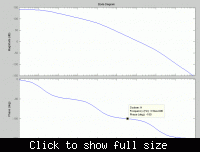aryajur
Advanced Member level 3
- Joined
- Oct 23, 2004
- Messages
- 793
- Helped
- 124
- Reputation
- 248
- Reaction score
- 37
- Trophy points
- 1,308
- Location
- San Jose, USA
- Activity points
- 7,788
Hello,
Attached is the frequency response of an ideal opamp (Except it has finite gain = 1e7) Poles are real at frequencies: 159Hz, 100Khz, 100MHz. So now the question is if we put this opamp in a unity gain feedback configuration (Opamp Buffer) and give a step input to the + terminal, what would be the frequency of the oscillating output?
Attached is the frequency response of an ideal opamp (Except it has finite gain = 1e7) Poles are real at frequencies: 159Hz, 100Khz, 100MHz. So now the question is if we put this opamp in a unity gain feedback configuration (Opamp Buffer) and give a step input to the + terminal, what would be the frequency of the oscillating output?
